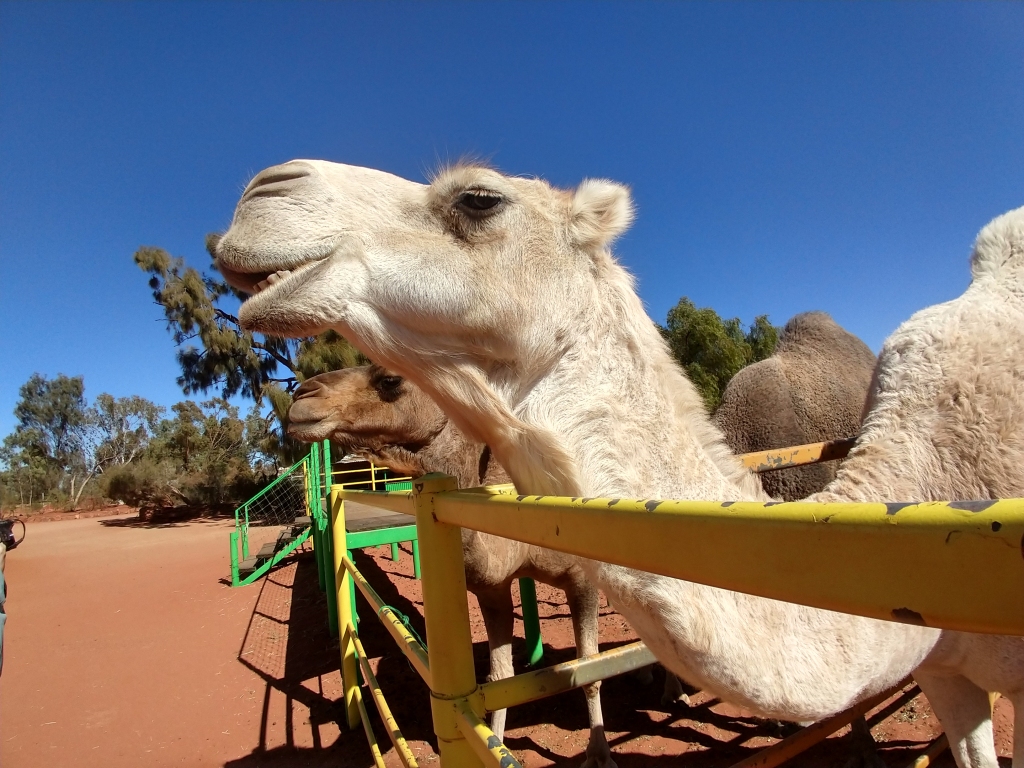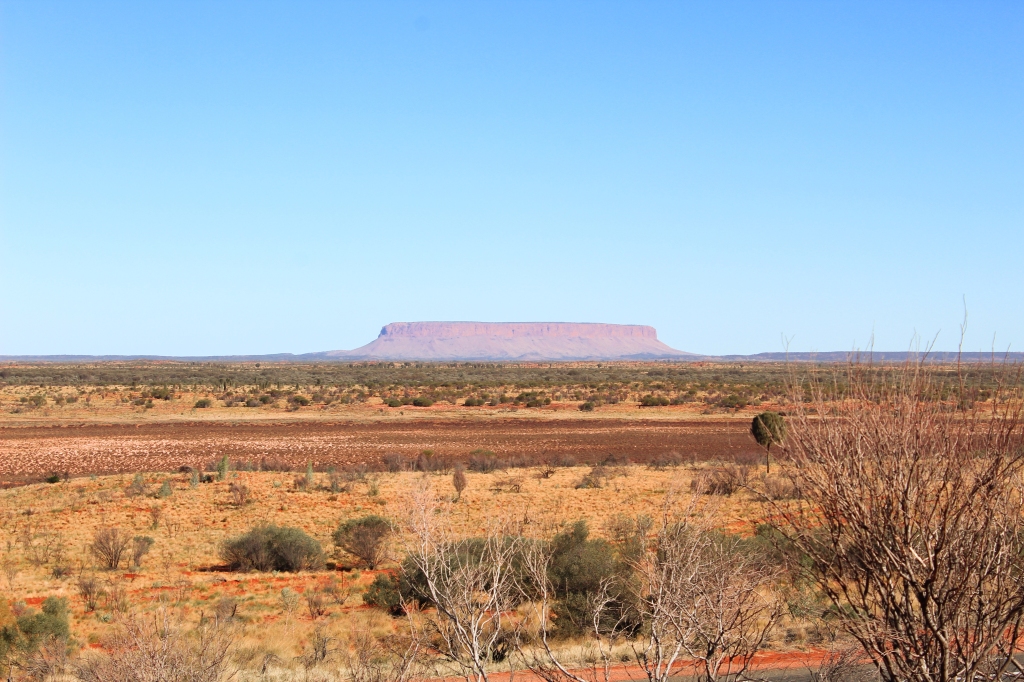Our three-day tour of the national park started in Alice Springs, way too early on a Monday morning for a night owl like me. We were on the bus before the sun was up, heading into the middle of the Outback. Our tour guide, Phil, let us sleep most of the morning before starting to spew incredible facts for the next three days. (Warning — this post is riddled with what some may consider to be an excessive amount of fun facts. Proceed with caution.)
From my window seat, I watched as the sky was painted with soft pastels that blended into the red earth. A scattering of trees silhouetted against the lightening sky just before the sun peaked its head over the horizon. A hot air balloon flicked into view, no doubt stealing the best views. It was hands down the most beautiful sunrise I had ever seen.
I was in and out of sleep for most of the morning — not necessarily because it was early, more likely due to my uncontrollable urge to sleep whenever in a moving vehicle. On our way down the long stretch of highway, we stopped to enjoy some friendly camels at Stuart’s Well.

Fun fact from Phil, Australia has the largest population of wild camels in the world, but they are not a native species. During the construction of the Ghan, the railroad through Australia’s center, camels were brought in to aid the workers.
However, once the railroad was complete, the camels were released into the wild where they bred and now are overabundant. The camels are very destructive to the native vegetation, and the government occasionally needs to issue cullings to keep the numbers under control. On an extra side note, the first camel to enter Australia was named Harry. But enough about camels, let’s get back to the story.
One of the most impressive-sounding things I did in Australia was stand in the exact geological center of the massive country, however the location itself was rather anti-climactic. At the geological center of Australia is the Erldunda Roadhouse, a quaint little restaurant and gift shop. There is nothing surrounding it for miles, so we took a pit stop to get gas and eat lunch. In three days time, this is where we would part ways with the majority of our group, a group made up of some of the most interesting people I have ever had the pleasure of meeting. But that’s what happens when you go to cool places, you meet cool people.
We browsed the shop for a little while after lunch and found some pretty unique souvenirs. I had packed very poorly for the weather, so I bought a sweatshirt along with some other knickknacks. I honestly don’t think I had enough warm clothes with me in Australia to have packed properly anyway.

Our final noteworthy stop was at Curtin Springs cattle station. Nothing about the station itself was interesting, but Mount Conner, a tabletop mountain, is located on the station land. Thousands of years ago, the ground was at the same level as the top of the mountain, but over time the ground around it eroded away. A hard layer of quartzite on top of the mountain kept the sand beneath it from eroding away, and eventually, the pressure from the weight of the sand layers turned the mountain into a hard sandstone.
Essentially everything you see in the Outback is red. I knew it was referred to as the Red Centre, but I had no idea that it was so literal. I was also surprised by the abundance of vegetation out there. There are trees and shrubs and tons of pale dead-looking grass, and much of it is drought resistant thanks to a large underground water source.
We spent hours on the bus driving through the desert staring at what seemed to be the same tree and an oddly familiar bush over and over, so you can only imagine how many facts we learned over that bus intercom. The root system of a desert oak tree is approximately double the size of the tree itself allowing it to reach deep into the ground for water. The main type of grass that surrounds Uluru and Kata Tjuta is spinifex grass. The native communities used the resin from the grass as glue for making spears. And so on.

Now don’t get me wrong, I’m not complaining. I was sitting there attentively in my seat listening to every word and swiping facts into the notes section of my phone as fast as I could keep up. For years, my main desire drawing me to visit Australia was my obsession with the diversity of the landscapes and variety of biomes. I was obsessed with Uluru because of its interesting geological history and sandstone formations, so you can imagine how intrigued I was with Phil’s scientific facts.
However, the most interesting discussions were those centered around the indigenous people and cultures of the area. The Anangu people are the traditional owners of the land, but for a while the government claimed ownership. It wasn’t until 1985 on October 26th, that they returned ownership to the Anangu people who still own the land today. The land is leased to Parks Australia, and together they manage Uluru-Kata Tjuta National Park.
Something about this didn’t sit right with me when I first heard it, and it still doesn’t sit well with me now. The Anangu survived off of the land for thousands of years, and are one of the oldest living cultures in the world. Aboriginals have lived in the area for over 30,000 years and some have been in the north for over 60,000 years. It has only been in the last 500 years that Europeans made contact with the Aboriginals, yet for a long while white folk took over their sacred land, and now we are exploiting it for the world to see. As fascinated and humbled as I was to experience this magical place, I couldn’t help but feel guilty as my dusty boots tread on the sacred grounds.
Uluru is the traditional name of the massive rock, but in 1873, an explorer named William Gosse named the rock Ayers Rock after the current Chief Secretary of South Australia. While the rock technically now has two names — the traditional and the English — the traditional name is used throughout the national park.

Similarly, the first non-Aboriginal to see Kata Tjuta was Ernest Giles in 1872. He then named the domes Mt. Olga, which eventually turned into the Olgas. Officially, it is dually named Kata Tjuta/Mount Olga, but in the national park, it is referred to at Kata Tjuta.
It wasn’t until the 1930s during the Great Depression that white people started coming here to hunt dingos, mine and for tourism. This was nearly 100 years ago, yet there are still native people alive today who remember what it was like before white people and some even remember the first contact. It is estimated, based on the number of languages present, that there were 300 different cultures in Australia before white people came. Now only about 50 healthy languages remain.
However, despite the destruction of the white man, culture is still preserved in the Uluru-Kata Tjuta National Park. The Mutitjulu community of Anangu people lives within the national park boundaries but is closed to tourists. To access the community you need a special permit or permission.
Likewise, when it comes to cultural stories — known as Dreamtime or Creation stories — they are not freely given. The stories that non-Aboriginals know are often the same stories they tell to small children to teach them life lessons. The deeper cultural stories told amongst adults are not shared with the public because these stories and cultural insights are something that must be earned throughout one’s life.
There is so much more about this culture that I would love to learn and share with you, but alas, our trip was only three days long and Phil could only spew so many facts to us.


